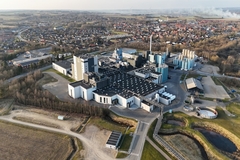
- Industry news
Industry news
- Category news
Category news
- Reports
- Key trends
- Multimedia
Multimedia
- Journal
- Events
- Suppliers
- Home
- Industry news
Industry news
- Category news
Category news
- Reports
- Key trends
- Multimedia
Multimedia
- Events
- Suppliers
Cargill expands global pectin footprint with US$150M processing facility in Brazil

09 Sep 2021 --- Cargill has inaugurated a US$150 million pectin production facility, located in Bebedouro – the heart of Brazil’s citrus-growing region. Its proximity to citrus fields ensures an abundant supply of fresh fruit peels, the raw material required for premium pectin production.
The facility will produce a full range of Cargill’s HM pectins, significantly increasing the company’s supply of the label-friendly texturizing ingredient and expanding production presence to two continents – South America and Europe.
“Demand for pectin is at an all-time high, fueled by global trends around sugar reduction and label-friendly formulation, as well as the popularity of fruit-flavored dairy drinks,” says Laerte Moraes, managing director for Cargill’s starches, sweeteners and texturizers business in South America.

“Adding a fourth pectin production facility to our supply network further secures our position as a reliable supplier of this sought-after ingredient.”
 The new pectin plant is located in close proximity to Cargill’s citrus fields.Initial shipments are expected to begin by year-end.
The new pectin plant is located in close proximity to Cargill’s citrus fields.Initial shipments are expected to begin by year-end.
Culmination of three-year pectin agenda
The Brazil plant opening culminates a three-year plan to expand Cargill’s global pectin production, which taps into market growth of 3 to 4 percent over the last several years.
Construction for this site began in June of 2019, building upon improvements to its existing pectin facilities in France, Germany and Italy.
With the combined added capacity, Cargill is now the world’s second largest pectin producer.
Serving a myriad of formulation roles
The versatile texturizer produced at Cargill’s new plant will be used to make jams, fruit-flavored beverages, acidic dairy drinks, yogurts, fruit preparations and confectionery, as well as personal care products.
In these applications, HM pectin fulfills a myriad of roles, serving as an excellent thickener and gelling agent, stabilizing proteins in acidic environments, and aiding in the production of sugar-reduced beverages.
Pectin is being sought after as a more label-friendly texturizer amid the current market demand for sustainable ingredients, which has similarly pushed up demand for other novel hydrocolloids based on seaweed, oat-fibers and cell-cultured gelatin.
Last year, the top category of global product launches tracked with hydrocolloids was Bakery (18 percent), according to Innova Market Insights data. Soy lecithin was the leading ingredient among the hydrocolloids tracked (19 percent).
.jpg) Label-friendly pectin is produced from citrus peels.The top positionings of global product launches tracked with hydrocolloids were “No Additives/Preservatives” (15 percent), “Gluten-Free” (14 percent) and “High Source of Protein” (9 percent).
Label-friendly pectin is produced from citrus peels.The top positionings of global product launches tracked with hydrocolloids were “No Additives/Preservatives” (15 percent), “Gluten-Free” (14 percent) and “High Source of Protein” (9 percent).
Green pectin production
In keeping with Cargill’s commitment to reduce Scope 1 and Scope 2 emissions across its operations, the new plant leverages advanced technologies to reduce its environmental footprint and includes sustainability certification of raw materials.
This starts with the plant’s proximity to its citrus suppliers and their Rainforest Alliance certified farms, which helps minimize CO2 emissions from raw material transport, promotes regenerative agriculture practices and extends to its state-of-the-art design.
The Bebedouro plant is powered by thermal energy generated from biomass and biogas, using sustainability practices already proven at other company facilities.
“This new plant is the latest example of how Cargill is working to lower our environmental impact across operations,” says Moraes.
“Within the last five years, we’ve reduced the energy consumption of our European plants by 20 percent. Our Bebedouro plant will continue that commitment, using advanced technology to minimize our carbon footprint.”
By Benjamin Ferrer










